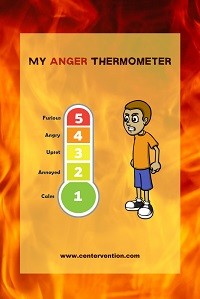
Everyone feels angry from time to time, and it can be an overwhelming emotion. Like other emotions, anger comes in different strengths or degrees – you can be just a little annoyed, or you can be boiling mad.
In this lesson, students will fill in an anger thermometer with situations that cause them to feel:
- Furious
- Angry
- Upset
- Annoyed
- Calm
For each of the top four feelings, they will write ideas for how they can calm down when that situation occurs. After completing the anger thermometer lesson, students will learn to recognize different levels of anger and identify strategies to manage their emotions effectively.
Recommended Grade Level: Elementary
SEL Skill(s): Emotion Regulation
Duration: 30 minutes
Materials:
- Anger Thermometer worksheet (Worksheet is available as a Supplemental Resource in your Centervention dashboard)
- Pencil, Pen, or Computer
Anger Thermometer Lesson
Introduction
Begin by explaining to the students that everyone feels angry sometimes, and it’s a normal emotion. Use a relatable personal example:
“Everyone feels angry sometimes. The other day, I felt angry because my cat scratched my favorite chair. When we get angry, it can be helpful to notice that we’re angry. That way, we can do something to help us get through the feeling without hurting anyone.”
Anger Thermometer Activity: 20 minutes
Explain the concept of an “anger thermometer”:
“Think of angry feelings like a thermometer. Sometimes you’re at a low temperature, feeling a little annoyed, but sometimes you’re all the way up at a really high temperature, feeling furious.”
Hand out the “Anger Thermometer” worksheet. The worksheet will have five sections labeled: Furious, Angry, Upset, Annoyed, and Calm.
Calm
Read the instructions aloud to the students:
- For each section of the thermometer, think of a time you felt that way or a situation that often makes you feel that way.
- Write down the situation in the appropriate section of the thermometer.
- For each of the top four feelings (Furious, Angry, Upset, Annoyed), write one idea for how you can calm down when that situation occurs.
Allow students time to fill out their worksheets. Walk around to provide help and ensure students understand the task.
Group Discussion: 10 minutes
Once students have completed their worksheets, gather them for a group discussion. Call on a few students to share their ideas and experiences.
Discussion Prompts:
- What are some situations that make you feel furious, angry, upset, or annoyed?
- What are some things you can do to help calm down when you feel this way?
- Can you think of any other strategies that might help someone else calm down?
Summarize the lesson by reinforcing the idea that understanding our emotions and having strategies to manage them is important. Remind students:
“Everyone feels angry sometimes, and that’s okay. What matters is how we handle our anger. By knowing how to calm down, we can feel better and avoid hurting ourselves or others.”
Additional Resources
Books
- Anger Management Skills Workbook for Kids by Amanda Robinson
- Me and My Feelings by Vanessa Green Allen
- H is for Happy by Evan Nimke (for younger students)
- The Way I Feel by Janan Cain
Related Lessons
- Anger Iceberg Worksheet
- List of Feelings
- Feelings Wheel
- Parent Resource: Helping an Angry Kid